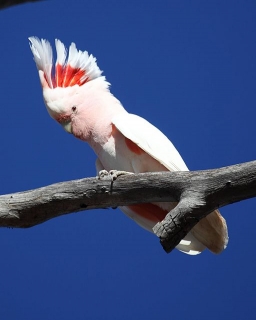Pink Cockatoo |
|
|
Also known as: Leadbeater's Cockatoo, Desert Cockatoo, Wee Juggler, Cocklerina, Chockalott
Photos
View in GalleryDid You Know?
The Major Mitchell's Cockatoo is the only cockatoo with a multicoloured crest.Academic Research
Related publications: Cacatua leadbeateriSpecies Profile
Genus: Cacatua | Species: leadbeateri
Size:
35cm (13.6 in)
Weight:
340-425g (12-14.9 oz)
Subspecies including nominate:
two: C.l. leadbeateri, C.l. mollis
Colour Adult:
C.l. leadbeateri: Male-white cockatoo with pink face, nape, chest and belly; brilliant red and yellow streaks in white crest. Dark pink forehead. Eye dark brown. Female-paler pink, wider band of yellow in crest, upper abdomen white instead of pink, eye reddish pink.
C.l. mollis: Both adults as in leadbeateri, but crest darker red with little or no yellow. Bill both races white.
Colour Juvenile:
Immatures similar to adult female with paler head and underparts.
Call:
High note, quavering. Harsh alarm call. Fledglings wheeze when calling for food.
Listen NowVideo Links:
Video 1More Information:
Content Sources:
CITES
BirdLife International
Cornell Lab of Ornithology/Birds of the World
NSW National Parks and Wildlife Service
A Guide to Parrots of the World, Juniper and Parr, 1998
Parrots of the World, Forshaw and Cooper, 1989.
Parrots of the World, Forshaw, 2006.
Parrots in Aviculture, Low, 1992.
Psittacine Aviculture, Schubot, Clubb and Clubb, 1992.
Avian Pediatric Seminar Proceedings, various authors, 1988.
Photos
View in GalleryDid You Know?
The Major Mitchell's Cockatoo is the only cockatoo with a multicoloured crest.Academic Research
Related publications: Cacatua leadbeateriSpecies Care
Captive Status:
Common in Australia, less so elsewhere.
Longevity:
May live 40-60 yrs.
Housing:
Walk-in cage, minimum length 4.5m (14.7 ft).
Diet:
Mix of small seeds: canary, oats, safflower, limited sunflower, spray millet. Sprouted sunflower, beans and lentils; green leaves such as: spinach, Swiss chard, lettuce, sowthistle, dandelion, chickweed; fresh vegetables such as: corn, carrot, celery, zucchini, green beans and peas, fruit if taken; nuts such as: walnuts, hazenuts, pecans and roasted peanuts. Complete kibble.
Enrichment:
Avid chewers so provide bird safe, unsprayed wood (fir, pine, elder, willow), wood toys, vegetable tanned leather toys, heat sterilized pine cones. Also provide overhead misters or shallow water bowls for bathing.
Nest Box Size:
Hollow log or vertical box with trap door.
Clutch Size:
2 to 4
Incubation Time:
25 days
Fledging Age:
8 weeks
Hatch Weight:
12g (0.4 oz)
Peak Weight:
399-403g (14-14.1 oz)
Weaning Weight:
311-319g (10.9-11.2 oz)
Photos
View in GalleryDid You Know?
The Major Mitchell's Cockatoo is the only cockatoo with a multicoloured crest.Academic Research
Related publications: Cacatua leadbeateriSpecies Wild Status
World Population:
Unknown, decreasing.
IUCN Red List Status:
Least Concern
CITES Listing:
Appendix II
Threat Summary:
Loss of habitat (although clearing for agricultural development has stopped in all states except Queensland) and because it is an ecological specialist it has faced downturns in its population with poor recovery potential; also trapping for wild bird trade. Serious decline in Victoria area.
Range:
C.l. leadbeateri: Interior of SE Australia from SW Queensland and W New South Wales to NW Victoria and CE South Australia.
C.l. mollis: Inland W and C Australia east to Eyre Peninsula and Lake Eyre basin, S Australia.
Habitat:
Mainly found in arid interior of Australia, favouring Eucalyptus woodland around rivers and ponds, also mulga, mallee, cypress and Acacia woodland, as well as farmland. Up to 300m (984 ft).
Wild Diet:
Seed such as Callitris, Casuarina, Ficus, Grevillea, Hakea, Proboscidea, Santalum, Acacia, Eremophila and Codonocarpus; paddy melon seed, pine cones, Eucalyptus seeds and bulbs, bitter wild melon seeds, nuts, roots, insect larvae.
Ecology and Behaviour:
May be found in the company of Galahs (Rose-breasted cockatoos) and Corellas; found in pairs or groups up to 50; will feed both on the ground and in trees.
Clutch and Egg Size:
2 to 4, ovate eggs, 40.0 x 29.5mm (1.5 x 1.2 in).
Breeding Season:
August to October. Nest is in tree hollow.
Related Links:
Photos
View in GalleryDid You Know?
The Major Mitchell's Cockatoo is the only cockatoo with a multicoloured crest.Academic Research
Related publications: Cacatua leadbeateriMembers Only Resources
Please log-in now to find more research, resources and tools.
Not a Member?
Find more great information:
Gain exclusive access to 600+ pages of additional research, seminars and podcasts, specialists to ask your toughest questions, and dozens of other fun resources - when you become a WPT member.
Join Today >>

































